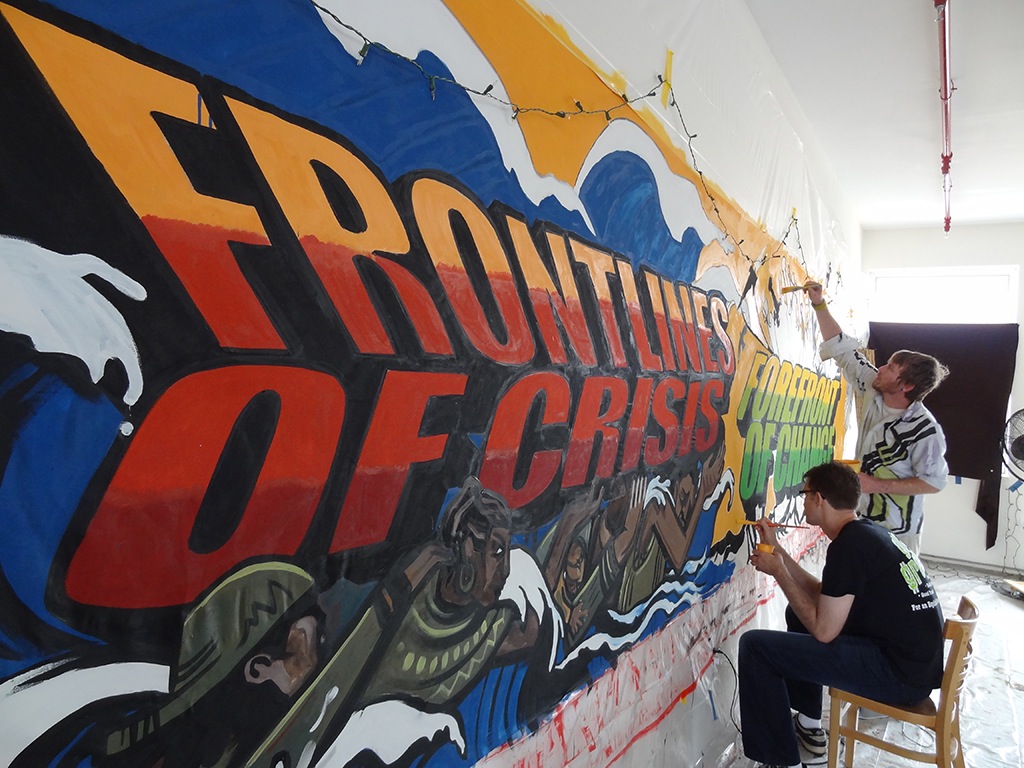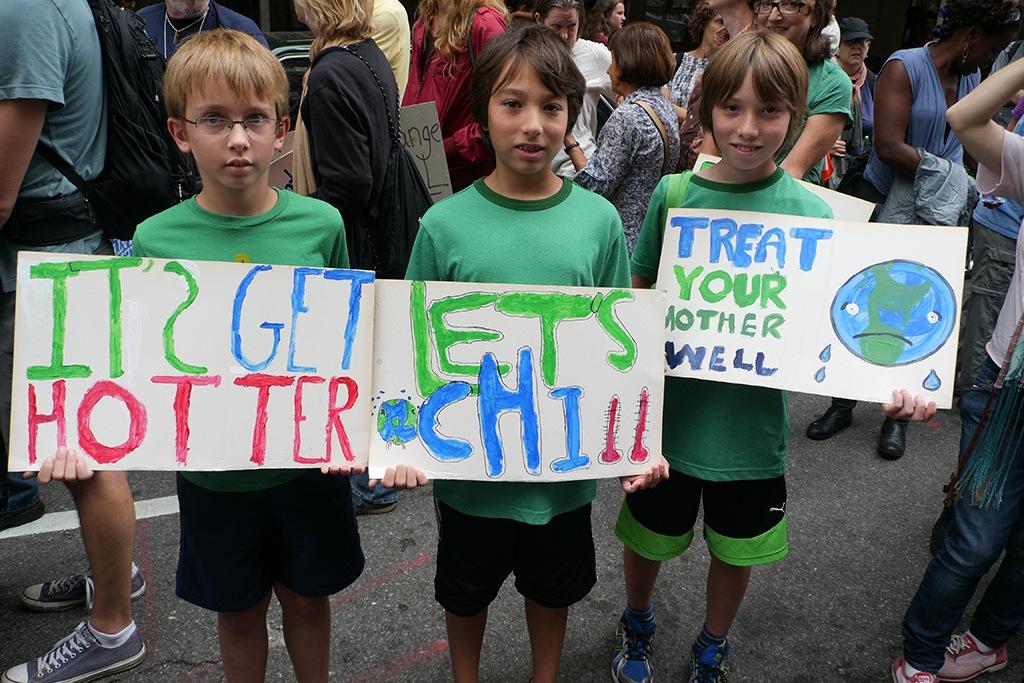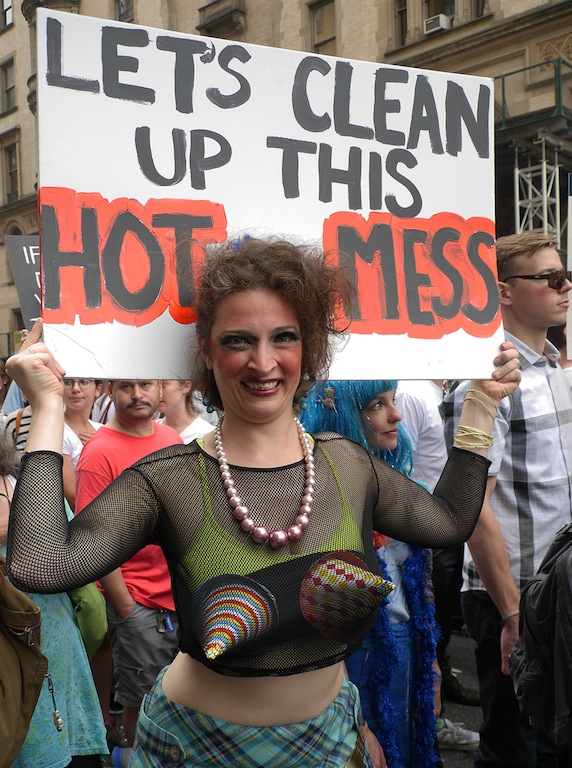As a child, I listened to the great songs of the civil rights movement — “We shall Overcome” and “Sinnerman” — and as I grew older, and studied Martin Luther King’s speech, “I had a Dream,” and rallies against the Vietnam War, I had no idea that my principles would be put to the same test of integrity in my lifetime. On September 12, I was reeling from the news that Prime Minister Harper had ratified FIPA, and that we were on the verge of losing legal recourse to protect our own environment, trumped by China’s right to invoke secretive tribunals to determine investor-state relations above our own Constitution.
A week later, I travelled on one of five packed buses to New York City organized by 350.org to march down 6th Avenue as part of the People’s Climate March and film NASA’s former head of Goddard Institute of Space Studies, Dr. James Hansen, at the request of my friend, Cheryl McNamara, leader of the Toronto Chapter of the Citizens’ Climate Lobby.
On Saturday, we stood at the Peace Fountain at St. John the Divine near Columbia University, and interviewed Dr. Hansen about climate change and whether other worlds were habitable. The answer was conclusive. In all of his scientific research, there was no other planet which could support human life: we are on the edge of losing our capacity for doing so on earth, but another political world is possible if carbon could be taxed at source and redistributed as dividends. As a supporter of the Citizens’ Climate Lobby, he was walking with his grandchildren the next day, concerned with getting philanthropic organizations to back this policy shift.
We then raced to Unitarian Church of All Souls to see the panel featuring organizer Bill McKibben, co-founder of 350.org, author Naomi Klein, socialist Seattle city council member Kshama Sawant and socialist Senator Bernie Sanders of Vermont. The line snaked around the block, but I managed to get in, determined to cover the event. Bill McKibben asked that people make noise at 1 p.m. during the march to “sound a burglar alarm on the people who are stealing the future.” Naomi Klein said that neoliberalism will never provide the solution to climate change — rather it entrenches it in treaties, such as NAFTA and FIPA — and that expanding parts of the economy such as health care and education could help shift the paradigm. Kshama Sawant spoke about creating a third party called “the 99%” to create an alternate choice to the two-party system, while Bernie Sanders demurred, and said there was still hope for the Democrats. Chris Hedges railed against the increased drilling and exploration by the oil and gas industry under President Obama, and lambasted the Democrats for exacerbating both climate change and the surveillance state.
‘There is nowhere else to go’
The next day, bedraggled from sleeping with one hundred others on the wooden floor of a church, Cheryl and I walked to West 72nd Street with Dr. Hansen and his grandchildren, and the Citizens Climate Lobby, who were carrying large dividend cheques made out to citizens. As I stood at the corner beside the Dakota, where John Lennon lived with Yoko Ono, people were pushing one way as they were leaving the subway, as others were pushing in the opposite direction, trying to join the larger march on 6th Avenue. Trapped in a crowd that easily could have become out of control, a New Yorker said, “There is nowhere else to go.” There was nowhere else to go. I was without access to water, unable to move, dirty and exhausted, and although I was in the midst of a compassionate crowd, I wondered if these limited resources lasted a lifetime, how would people behave? As I looked up, a police helicopter circled midtown Manhattan, counting heads, and a drone dangling a GoPro documented the numbers from a bird’s eye view. And I thought — this is already happening. We are all being held hostage to environmental deregulation and surveillance.
Already every centimetre of Canada is being analyzed through geographic information systems (GIS) to inventory the value of our oil, gas and mineral deposits as our water is being privatized, our Boreal forest is being cut down for the tarsands, and our waterways polluted by tailings ponds. Soon, we will have no legal access to legislation to protect our own environment through the investor-state relations agreement of FIPA, or prioritize Canadian municipal contracts through CETA. And as our universal health-care system becomes overburdened from this environmental pollution, it will provide yet another excuse to privatize health care. We will lose so much through these trade agreements, that Lead Now and the Council of Canadians are mounting constitutional challenges against their ratification. FIPA could come fully into effect on October 1, and CETA ratified by September 26.
People across ages and nationalities come together
It was so crowded that a police officer put a blue and white caution tape across the subway entrance, and told people to go back into the subway system so that they would not add to the throng. Hot, and frustrated that I couldn’t cover the march as a photojournalist, I became contemplative, and thought of my time studying in NYC, and how times have changed since I left. To distract myself, I began to photograph the crowd around me, and said to a woman, “Your lipstick is smeared.” She said, “That’s the point.” Carrying a placard reading “Let’s Clean up this Hot Mess,” with paper party hats for her Dolce & Gabbana bra, rubber bands around her wrists, and a preppy outfit gone awry, she was a climate hangover incarnate.
Still landlocked, I thought about John Lennon’s assassination near the Dakota, and knew that just as Yoko and Sean have been vocal about fracking in New York State, if he were still alive, John and his family would have been marching with the thousand Indigenous people at the front of the march, just after the youth who led the march, holding placards covered with sunflowers. Al Gore, New York Mayor Bill de Blasio, UN Secretary-General Ban Ki-Moon, Sting, and Leonard DiCaprio were there, behind the “Frontlines of Crisis, Forefront of Change” banner, although Stephen Harper refused to attend either the summit or the march.

Photo: Elizabeth Littlejohn
Finally, two hours later, the crowd moved on to 6th Avenue. A small contingent began to sing “We Shall Overcome,” linking environmental racism with the civil rights movement, and the historic route we marched. I travelled on, speaking with vegans, beekeepers protesting neonicotinoids, people from Rockaway Beach whose homes had been devastated by Hurricane Sandy, and the famous anti-nuke activist, Kevin D. Blanch, at the United Nations Plaza. Diagnosed with leukemia, he spoke to two young women about the nuclear industry as controlled by two corporations, and how to hold them to account. An artist stood in front of a landscape, holding up a sign saying, “Support peace in Afghanistan, Iran, Syria, Iraq,” to point out that without peace, we cannot address climate change. Nearby, a gay leopard posed with two signs, “Protect Gay Leopards” and “Cook Organic. Not the Planet.”
I continued to race along the 42-block march route, mesmerized by the range of ages and nationalities, trying to reach the front, where First Nations protesting the tarsands and Aztec, Ecuadorian and Amazonian dancers ended the march in a roundhouse dance. An exquisite video of this contingent by the Idle No More media team can be seen here.
Climate activists are everywhere
Returning home, I decompressed by looking over hundreds of photographs and dozens of videos, donated to 350.org by citizen journalists, and tried to piece together what I missed, revelling in their beauty. Coverage of 6,800 events in 162 countries of the People’s Climate March was archived by 350.org, and will be made accessible to activists to cut their own documentaries with open-source material. I played Pete Seeger’s “We Shall Overcome” to remind myself of the lyrics, and was surprised that “We shall not be Afraid” was one of the last verses. I thought of the mainstream media’s current focus on ISIS, and vilification of climate change activists as a distraction to avoid the most difficult conversation in our lifetime, a united solution to climate disruption.

Photo: Elizabeth Littlejohn
As so many have been impacted by climate change, climate activists are everywhere. Internationally, people do have a choice to continue unbridled consumerism, but I believe that the vast majority of us will stop pushing and pulling in opposite directions when the going gets rough — to go in one political direction to re-introduce environmental regulation, impose fee and dividend on carbon, end oil and gas subsidies, and implement renewable energy sources. The march’s central message to the United Nations was to focus on climate change as the highest priority, but in the immediate future, I believe that as Canadians, we will continue to bypass our present government to self-govern and fulfill our need for change through inner-city gardening, skill and resource sharing, food co-ops, and centres for social innovation. Our current government is so far behind the collective outpouring of our political will for greenhouse gas reduction that we are doing it ourselves, with or without its leadership, presence and support, just as we marched as one on September 21 with 400,000 others committed to changing our environmental future in one of the largest mass protests in America’s history. As Leonard DiCaprio said in his speech to the United Nations Climate Summit two days later, “It is not a question of politics, it is a question of our own survival. The time to answer humankind’s greatest challenge is now.”
Elizabeth Littlejohn teaches sustainable design, social innovation and new media. The column “Design for Democracy” focuses on sustainable design solutions for a greener future.
Photos courtesy of Elizabeth Littlejohn.




